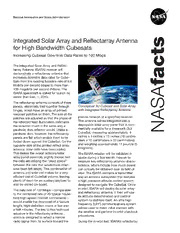
NASA Technical Reports Server (NTRS) 20150023535: Integrated Solar Array and Reflectarray Antenna for High Bandwidth Cubesats PDF
Preview NASA Technical Reports Server (NTRS) 20150023535: Integrated Solar Array and Reflectarray Antenna for High Bandwidth Cubesats
Integrated Solar Array and Reflectarray Antenna for High Bandwidth Cubesats Increasing Cubesat Downlink Data Rates to 100 Mbps The Integrated Solar Array and Reflec- tarray Antenna (ISARA) mission will demonstrate a reflectarray antenna that increases downlink data rates for Cube- Sats from the existing baseline rate of 9.6 kilobits per second (kbps) to more than 100 megabits per second (Mbps). The ISARA spacecraft is slated for launch no earlier than Dec. 1, 2015. The reflectarray antenna consists of three Conceptual 3U Cubesat and Solar Array panels, electrically tied together through with Integrated Reflectarray Antenna hinges, which have an array of printed, resonant patches on them. The size of the precise location of a specified receiver. patches are adjusted so that the phase of This antenna will be integrated into a the reflected feed illumination collimates deployable solar array panel that is com- the radiation much in the same way a mercially available for a three-unit (3U) parabolic dish reflector would. Unlike a CubeSat, measuring approximately 4 parabolic dish, however, the reflectarray inches x 4 inches x 13 inches (10 centim- panels are flat which enable them to be eters x 10 centimeters x 33 centimeters) folded down against the CubeSat. On the and weighing approximately 11 pounds (5 opposite side of the printed reflect array kilograms). antenna, solar cells have been added. This makes the overall antenna/solar The ISARA mission will be validated in array panel assembly slightly thicker, but space during a five-month mission to the cells are utilizing the “dead space” measure key reflectarray antenna charac- between the rails that would have other- teristics, which include how much power wise been left empty. This combination of can actually be obtained over its field of antenna and solar cell makes for a very view. The ISARA contains a transmitter efficient use of CubeSat volume, leaving and an avionics subsystem that features plenty of room for an auxiliary payload to a high precision attitude control system also be stored on-board. designed to navigate the CubeSat. Once in orbit, ISARA will deploy its solar array The data rate of 100 Mbps—comparable and reflectarray antenna. It then will use to the combined rate of 20 typical house- its attitude determination and control hold high-speed Internet connections— system to stabilize itself. An ultra high would enable the download of a feature frequency (UHF) communications system length, high-definition movie in five and will be used to make initial contact with a half minutes. The key to this technical the satellite and perform in-orbit checkout advance is the reflectarray antenna , procedures. which is designed to reflect a narrow radio signal from its surface toward the During the in-orbit test, ISARA’s reflectarray antenna will transmit a signal that will be received ISARA’s spacecraft will be launched and deployed by a ground station located at NASA’s Jet Propul- as an auxiliary spacecraft on a rideshare mission ar- sion Laboratory (JPL) in Pasadena, California. The ranged by the Launch Services Program at NASA’s spacecraft’s location and orientation telemetry data Kennedy Space Center. will be analyzed to reconstruct the antenna signal The ISARA mission is funded through NASA’s Small pattern, which will then be compared against pre- Spacecraft Technology Program (SSTP), which flight ground measurements. is chartered to develop and mature technologies At the end of the validation mission, the reflectarray to enhance and expand the capabilities of small antenna technology will be available for use on other spacecraft with a particular focus on communica- missions which need high bandwidth telecommunica- tions, propulsion, pointing, power, and autonomous tions. The ISARA technology will enable CubeSats operations. SSTP is one of nine programs within and other small satellites to serve as viable platforms NASA’s Space Technology Mission Directorate. for performing missions that were previously only pos- For more information about the SSTP, visit: sible on larger and more costly satellites. For a mod- http://www.nasa.gov/smallsats est increase in mass, volume and cost, the high data rate this technology enables will pave the way for high For more information about ISARA, please contact: value science missions and formation flying missions Dorothy Lewis that use distributed CubeSats and small satellites. ISARA Project Manager Jet Propulsion Laboratory The ISARA payload is being developed by JPL [email protected] and will be demonstrated on a CubeSat developed Andres Martinez by The Aerospace Corporation in El Segundo, Small Spacecraft Technology Program Manager California. JPL partnered with Pumpkin Inc. in San Space Technology Mission Directorate Francisco, California, to develop the solar array. NASA Ames Research Center ISARA was selected for a flight opportunity as part [email protected] of the CubeSat Launch Initiative in NASA’s Human Andrew Petro Exploration and Operations Mission Directorate. Small Spacecraft Technology Program Executive Space Technology Mission Directorate NASA Headquarters [email protected] ISARA Reflectarray Antenna Reflectarray Feed Antenna National Aeronautics and Space Administration Ames Research Center Moffett Field, CA 94035 NASA Facts FS #2015-03-21-ARC
